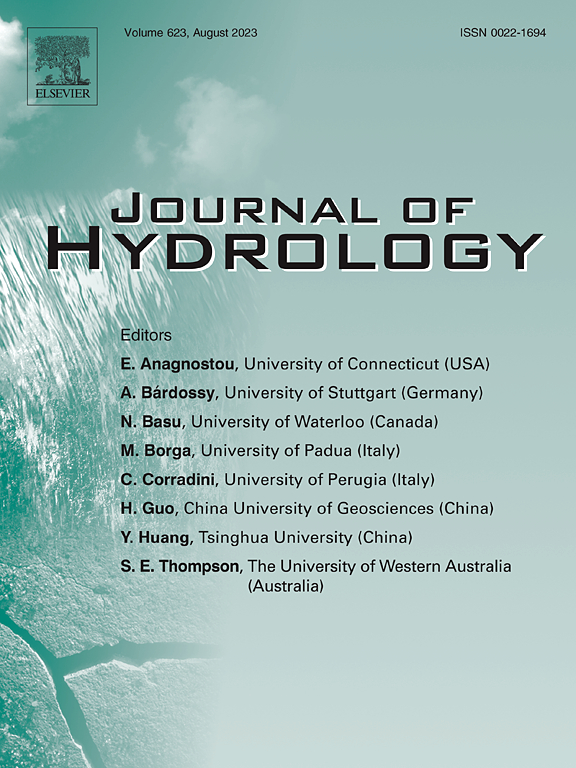Spatial pattern of amount effect of daily precipitation isotopes in China: A consideration of seasonality based on observation and simulation
IF 5.9
1区 地球科学
Q1 ENGINEERING, CIVIL
引用次数: 0
Abstract
The negative correlation between precipitation amount and precipitation δ18O, also known as the amount effect, is considered one of the main environmental controls of precipitation isotopes. As isotope observations increase, there is a debate about the spatial patterns of amount effect especially on a daily scale. Based on observations at 150 sampling stations and an isotope-enabled climate model, here we examined the amount effect of precipitation isotopes across China from humid to arid climate conditions. The observations and simulations indicated that the spatial distribution of amount effect of daily precipitation isotopes for each season is not limited to the traditional low latitudes. When the seasonality of precipitation isotopes is filtered or reduced, the areas with amount effect on a daily scale are enlarged. On a daily scale, there is a spatially coherent amount effect in summer, while in other seasons some areas without an amount effect can also be observed, especially in the northeastern part of China in winter. Except for summer, the precipitation extremes do not always lead to isotope depletion, which may be related to relatively higher temperatures during precipitation extremes in these areas. After the seasonality is eliminated, as the time scale increases from daily to monthly and annual scale, the spatial patterns of amount effect are generally similar. The seasonality of spatial patterns of amount effect is associated with atmospheric circulation. The findings provide a perspective of seasonality removal to understand the amount effect of precipitation isotopes, and are useful for understanding the changing isotope signatures in an accelerated hydrological cycle.
中国日降水同位素量效应的空间格局:基于观测和模拟的季节性考虑
降水量与降水δ18O之间的负相关关系也称为量效应,被认为是降水同位素的主要环境控制因素之一。随着同位素观测的增加,关于量效应的空间格局,特别是在日尺度上,存在争论。基于150个采样站的观测数据和同位素气候模型,研究了中国各地从湿润到干旱气候条件下降水同位素的数量效应。观测和模拟结果表明,各季节日降水同位素量效应的空间分布并不局限于传统的低纬度地区。当降水同位素的季节性被过滤或减少时,在日尺度上具有量效应的区域被扩大。在日尺度上,夏季存在空间连贯的量效应,而在其他季节,也可以观测到一些不存在量效应的地区,特别是冬季的东北地区。除夏季外,极端降水并不总是导致同位素耗竭,这可能与极端降水期间这些地区相对较高的温度有关。在剔除季节因素后,随着时间尺度从日尺度增加到月尺度和年尺度,数量效应的空间格局基本相似。量效应空间格局的季节性与大气环流有关。这些发现为理解降水同位素的数量效应提供了去除季节性的视角,并有助于理解加速水文循环中同位素特征的变化。
本文章由计算机程序翻译,如有差异,请以英文原文为准。
求助全文
约1分钟内获得全文
求助全文
来源期刊

Journal of Hydrology
地学-地球科学综合
CiteScore
11.00
自引率
12.50%
发文量
1309
审稿时长
7.5 months
期刊介绍:
The Journal of Hydrology publishes original research papers and comprehensive reviews in all the subfields of the hydrological sciences including water based management and policy issues that impact on economics and society. These comprise, but are not limited to the physical, chemical, biogeochemical, stochastic and systems aspects of surface and groundwater hydrology, hydrometeorology and hydrogeology. Relevant topics incorporating the insights and methodologies of disciplines such as climatology, water resource systems, hydraulics, agrohydrology, geomorphology, soil science, instrumentation and remote sensing, civil and environmental engineering are included. Social science perspectives on hydrological problems such as resource and ecological economics, environmental sociology, psychology and behavioural science, management and policy analysis are also invited. Multi-and interdisciplinary analyses of hydrological problems are within scope. The science published in the Journal of Hydrology is relevant to catchment scales rather than exclusively to a local scale or site.
 求助内容:
求助内容: 应助结果提醒方式:
应助结果提醒方式:


